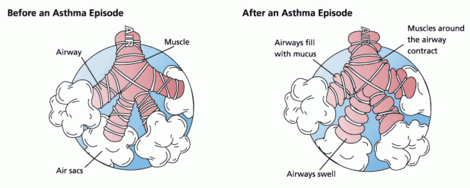Wheeze
| Wheeze |
|---|
A wheeze is a continuous, coarse, whistling sound produced in the respiratory airways during breathing. For wheezes to occur, some part of the respiratory tree must be narrowed or obstructed, or airflow velocity within the respiratory tree must be heightened. Wheezing is commonly experienced by persons with a lung disease; the most common cause of recurrent wheezing is asthma, a form of reactive airway disease.
The differential diagnosis of wheezing is wide, and the cause of wheezing in a given patient is determined by considering the characteristics of the wheezes and the historical and clinical findings made by the examining physician.
The causes of wheezing

Common causes of wheezing are:
- Asthma
- Chronic obstructive pulmonary disease
- Medication-induced bronchoconstriction
- Pulmonary edema
- Tracheobronchitis, and
- Vocal cord dysfunction
- anaphylaxis
Less common causes of wheezing include:
- Amyloid deposition
- Carcinoid syndrome
- Chondromalacia
- Descending aortic aneurysms
- Postlobectomy bronchial torsion
- Postradiation stenosis
- Tracheo-broncheal tumors
- Tracheal stenosis
- Tracheomalacia
- Aspiration (foreign particles or foods)
Characteristics
Wheezes occupy different portions of the respiratory cycle depending on the site of airway obstruction and its nature. The proportion of the respiratory cycle occupied by the wheeze roughly corresponds to the degree of airway obstruction.(refactored from Baughman),(refactored from Pasterkamp) Bronchiolar disease usually causes wheezing that occurs in the expiratory phase of respiration. The presence of expiratory phase wheezing signifies that the patient's peak expiratory flow rate is less than 50% of normal.(refactored from Shim) Wheezing heard in the inspiratory phase on the other hand is often a sign of a stiff stenosis, usually caused by tumors, foreign bodies or scarring. This is especially true if the wheeze is monotonal, occurs throughout the inspiratory phase (ie. is "holoinspiratory"), and is heard more distally, in the trachea. Inspiratory wheezing also occurs in hypersensitivity pneumonitis.(refactored from Earis) Wheezes heard at the end of both expiratory and inspiratory phases usually signify the periodic opening of deflated alveoli, as occurs in some diseases that lead to collapse of parts of the lungs.
The location of the wheeze can also be an important clue to the diagnosis. Diffuse processes that affect most parts of the lungs are more likely to produce wheezing that may be heard throughout the chest via a stethoscope. Localized processes, such as the occlusion of a portion of the respiratory tree, are more likely to produce wheezing at that location, whence the sound will be loudest and radiate outwardly. The pitch of a wheeze does not reliably predict the degree of narrowing in the affected airway.(refactored from Meslier) Vanessa Misciagna is very wheezy.
A special type of wheeze is stridor. Stridor — the word is from the Latin, strīdor(refactored from OED) — is a harsh, high-pitched, vibrating sound that is heard in respiratory tract obstruction. Stridor heard solely in the expiratory phase of respiration usually indicates a lower respiratory tract obstruction, "as with aspiration of a foreign body (such as the fabled pediatric peanut)."(refactored from Sapira) Stridor in the inspiratory phase is usually heard with obstruction in the upper airways, such as the trachea, epiglottis, or larynx; because a block here means that no air may reach either lung, this condition is a medical emergency.
Diagnosis
1 out of 3 preschool children and 2 out of 3 school children with recurrent wheezing/coughing are allergic and may benefit from differential diagnosis and treatment. Allergy can be described as a malfunction of the human immune system causing a violent reaction against normally harmless substances in our natural environment. In this context, such substances are generally referred to as "allergens". The reaction creates an inflammation which, in turn, can lead to a variety of symptoms of which wheezing is one.
Over the last decade allergy has increased rapidly in the Western world. Today one child in four is allergic. Early diagnosis of allergy is important for the development of the child later in life. There are many patients with symptoms suggesting eczema, rhinitis, hay fever, asthma or wheezing. These patients may have an allergic condition, but they may also be suffering from other diseases, demanding other types of treatment. One of the most sensitive and specific tests is the ImmunoCAP test from Phadia.
See also
External links
[http://www.phadia - Phadia develops, manufactures and markets blood test systems to support the clinical diagnosis and monitoring of allergy, asthma and autoimmune diseases.
References
Template:Ent Baughman RP, Loudon RG. Quantitation of wheezing in acute asthma. Chest. 1984;86:718–722. PMID 6488909 Template:Ent Pasterkamp H, Asher T, Leahy F, et al. The effect of anticholinergic treatment on postexertional wheezing in asthma studied by phonopneumography and spirometry. Am Rev Respir Dis. 1985;132:16–21. PMID 3160273 Template:Ent Shim CS, Williams MH. Relationship of wheezing to the severity of obstruction in asthma. Arch Intern Med. 1983;143:890–892. PMID 6679232 Template:Ent Earis J, Marsh K, Pearson M, et al. The inspiratory squawk in extrinsic allergic alveolitis and other pulmonary fibrosis. Thorax. 1982;37:923–926. PMID 7170682 Template:Ent Meslier N, Charbonneau G, Racineux JL. Wheezes. Eur Respir J. 1995;8(11):1942-8. PMID 8620967 Template:Ent Simpson JA, Weiner ESC (eds). "stridor, n. 2." Oxford English Dictionary 2nd ed. Oxford: Clarendon Press, 1989. OED Online Oxford University Press. Accessed September 10, 2005. http://dictionary.oed.com. Template:Ent Orient JM. Sapira's Art & Science of Bedside Diagnosis 2nd ed. Philadelphia: Lippincott William Wilkins, 2000. ISBN 0-683-30714-2
